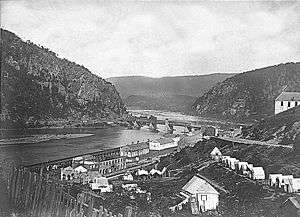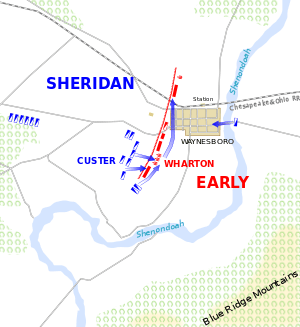Kenton Harper
| Kenton Harper | |
|---|---|
| Born |
1801 Chambersburg, Pennsylvania |
| Died |
December 25, 1867 (aged 65–66) Staunton, Virginia |
| Buried at | Thornrose Cemetery in Staunton |
| Allegiance |
|
| Service/branch |
|
| Years of service |
1846–48 (USA) 1861–64 (CSA) |
| Rank |
|
| Battles/wars |
Mexican–American War American Civil War |
Kenton Harper (1801 – December 25, 1867) was an American printer, soldier, town mayor, banker, newspaper editor, and legislator. He served as an officer in the U.S. Army during the Mexican–American War and later as a Confederate general officer during the American Civil War. He also reportedly played a role in the nicknaming of Stonewall Jackson.
Early life and career
Harper was born in 1801 in the city of Chambersburg in Franklin County, Pennsylvania. He was a son of George Kenton Harper, publisher of the Franklin County Repository newspaper, and his wife Nancy McClintock. During his youth Harper worked as a printer in Chambersburg. In 1823 he moved to Staunton, Virginia, and bought a local newspaper called the Republican Farmer. In time it would become known as the Staunton Spectator, which he would publish until 1849, and Harper began serving as a state legislator in 1836.[1] Later he also served as the mayor of Staunton.[2]
During the Mexican War, Harper was a captain in the 1st Virginia Infantry, commanding the volunteer company from Augusta County that served in the northern frontier of Mexico. However he never saw combat and returned home to muster out in August 1848.[3] Harper then was appointed acting inspector general of his brigade, and later was the military governor of Parras in the Mexican state of Coahuila. From 1851 to 1852, he was the United States agent to the Chickasaws at Fort Washita in the Indian Territory. After the war, Harper served as the assistant U.S. Secretary of the Interior in Washington, D.C. He also was appointed president of a Staunton-area bank, and in 1860 Harper was appointed a major general in Virginia's state militia.[1]
By the U.S. Census of 1860, Harper had married Ellen Calhoun and they had three children together; a son named Samuel and two daughters named Nancy and Mary. Ellen's sister Catherine Calhoun also lived with the family at this time.[4] Harper's son Samuel C. was born in Virginia on October 4, 1831. He would also serve in the Confederate Army, enlisting on August 6, 1862, in Staunton and was later was a quartermaster sergeant in the 62nd Virginia Infantry. Samuel would die on November 5, 1901, and be buried in the Augusta Stone Presbyterian Church Cemetery.[5]
American Civil War service

When the Civil War began in 1861 Harper chose to follow his home state and the Confederate cause. Still a major general in Virginia's state militia, he was given command of the 5th Virginia Infantry Regiment on April 10.[2] Eight days later a force of 2,400 men led by Harper and Brig. Gen. William H. Harman seized the U.S. Army arsenal located at Harpers Ferry in modern-day West Virginia. Despite the fires set by the Union Army forces as they withdrew, Harper's militia were able to salvage 4,000 of the approximately 15,000 muskets in storage there, as well as 300 of the arsenal's milling machines and metal working lathes, plus about 57,000 tools and wooden stocks, all items used in rifle production. Throughout the month this material was sent to Richmond, Virginia. On April 28 Confederate Col. Thomas J. "Stonewall" Jackson arrived to assume command of the forces at Harpers Ferry and began to organize the militia into regiments.[6][7]
On May 1, 1861, Harper was appointed a brigadier general in the Virginia Provisional Army, an organization soon to be added to the overall Confederate States Army. Seven days later he was commissioned a colonel and given command of the 5th Virginia Infantry, one of the regiments that made up the Stonewall Brigade. Harper and the 5th Virginia fought well during the First Battle of Bull Run on July 21, "where his soldierly ability attracted the notice of the army commander."[8] He resigned from the Confederate Army on September 11 following Jackson's refusal to grant permission for Harper to return home to be with his terminally ill wife.[9]

Harper returned home to the Shenandoah Valley and was again elected into Virginia's legislature to represent this area until 1864. On June 2 of that year Harper was re-appointed a colonel in the Confederate Army and given permission to form a regiment out of the reservist companies located in the Shenandoah Valley. He led them during the Valley Campaigns of 1864, taking part in the Battle of Piedmont on June 5–6, and then the Battle of Waynesboro, Virginia on March 2, 1865. Harper's command was routed during both of these Confederate defeats.[1]
Postbellum
After the conflict, Harper returned home to Staunton in 1865. Two years later he died of pneumonia on Christmas Day at his plantation, "Glen Allen", and was buried in Staunton's Thornrose Cemetery.[2] During his lifetime, Harper was allegedly credited with drawing the attention of Brig. Gen. Bernard E. Bee to Stonewall Jackson's performance during the First Battle of Bull Run, inspiring Jackson's famous sobriquet.[10]
See also
Notes
- 1 2 3 Allardice, More Generals in Gray, p. 117.
- 1 2 3 Eicher, Civil War High Commands, p. 281.
- ↑ Waddell, Annals of Augusta County, Virginia, p. 271; Eicher, Civil War High Commands, p. 281.
- ↑ "1860 Population Census, Virginia Center for Digital History, Univ. of Virginia". valley.lib.virginia.edu. Retrieved 2009-09-30.
- ↑ "Samuel Harper Confederate service file". virginia.edu. Retrieved 2009-09-30.
- ↑ "Harpers Ferry during the Civil War". encyclopediavirginia.org. Retrieved 2009-09-30.
- ↑ Eicher, Longest Night, p. 53; Allardice, More Generals in Gray, p. 117.
- ↑ Allardice, More Generals in Gray, p. 117; Eicher, Civil War High Commands, p. 281.
- ↑ Cozzens, Shenandoah 1862: Stonewall Jackson's Valley Campaign, p. 12.
- ↑ Allardice, More Generals in Gray, p. 118.
References
- Allardice, Bruce S., More Generals in Gray, Louisiana State University Press, 1995, ISBN 0-8071-3148-2.
- Cozzens, Peter, Shenandoah 1862: Stonewall Jackson's Valley Campaign. University of North Carolina Press, 2008. ISBN 0-8078-3200-6.
- Eicher, David J., The Longest Night: A Military History of the Civil War, Simon & Schuster, 2001, ISBN 0-684-84944-5.
- Eicher, John H., and Eicher, David J., Civil War High Commands, Stanford University Press, 2001, ISBN 0-8047-3641-3.
- Waddell, Joseph A., Annals of Augusta County, Virginia. Richmond: William Ellis Jones, 1886.
- online
- encyclopediavirginia.org Harpers Ferry during the Civil War.
- valley.lib.virginia.edu A 1860 Population Census, Virginia Center for Digital History, University of Virginia.
- valley.lib.virginia.edu B Samuel Harper Confederate service file.
Further reading
- Hearn, Chester G., Six Years of Hell: Harpers Ferry During the Civil War, Louisiana State University Press, 1996, ISBN 978-0-8071-2440-6.